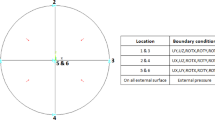Abstract
To better understand the implosion and the resultant shock wave, a series of numerical modeling and simulations were undertaken for the buckling and collapse of spherical and cylindrical shell structures. The shells were assumed to be made of steel, aluminum, and laminated fibrous composites, respectively. First, the buckling was examined for the shell structures subjected to external pressure loading without any contact with fluid media. Both static and dynamic buckling was studied. For the dynamic buckling, the speed of collapse was controlled to investigate its effect on the buckling characteristics such as buckling mode. This was achieved by decreasing the internal pressure at different rates as the structures were subjected to a constant external pressure. Then, the full implosion process associated with the collapse of shell structures was modelled and studied to understand the shock wave propagation radiated from the collapsing shell structures. The structures were initially subjected to an external water pressure equivalent to a specified water depth. Then, the collapse speed of the shells was controlled, too. Finally, the effect of an initial defect on the buckling and implosion of cylindrical shells was examined. The numerical study compared the implosion characteristics resulting from spherical and cylindrical shells, different material properties, and various controlled collapse speeds. The results suggested that there were optimal parameters which generate the maximum peak pressure during the implosion process.

























































Similar content being viewed by others

References
Farhat C, Wang KG, Main A, Kyriakides S, Lee L-H, Ravi-Chandar K, Belytshko T (2013) Dynamic implosion of underwater cylindrical shell: experiments and computations. Int J solids Struct 50:2943–2961
Gilmore FR (1952) The growth of collapse of a spherical bubble in a viscous compressible liquid, Hydrodynamic laboratory, California Institute of Technology, California
Gupta S, Parameswaran V, Sutton MA, Shukla A (2014) Study of dynamic underwater implosion mechanics using digital image correlation. Proc R Soc Math Phys Eng Sci 470(2172):20140576
Ilinskii YA, Zabolotskaya EA, Hay TA, Hamilton MF (2012) Models of cylindrical bubble pulsation. J Acoust Soc Am 132:1346
Isaacs JD, Maxwell AE (1952) The ball-breaker, a deep water signaling device. J Mar Res 11:63–68
Kedrinskii VK (2005) Hydrodynamics of explosion: Experiments and Models. Springer, Berlin, Heidelberg, New York
Krueger SR (2006) Simulation of cylinder implosion initiated by an underwater explosion, Naval Postgraduate School, Monterey
Livemore Software Technology (LST) (2019), LS-DYNA Theory Manual. LST web site. https://www.lstc.com/download/manuals
Orr M, Schoenberg M (1976) Acoustic signatures from deep water implosions of spherical cavities. J Acoust Soc Am 59(5):1155–1159
Pinto M, Gupta S, Shukla A (2015) Hydrostatic implosion of GFRP composite tubes studied by digital image correlation. J Press Vessel Technol Oct 137(5):051302
Pinto M, DeNardo NA, Shukla A (2018) Geometric impact on the implosion energy and failure mechanics of carbon composite tubes, Multiscale and Multidiscip. Model Exp and Des 1:171–179
Plesset MS (1949) The dynamics of cavitation bubbles. J Appl Mech 16:228–231
Rayleigh L (1917) On the pressure developed in a liquid during the collapse of a spherical cavity. Philoso Mag 34:94–98
Sugimoto S, Kwon YW (2020) Implosion of spherical and cylindrical air cavities. Multiscale Multidiscip. Model. Exp. and Des. https://doi.org/10.1007/s41939-020-00074-2
Timoshenko SP, Gere JM (1961) Theory of elastic stability. McGraw-Hill, New York
Turner SE (2007) Underwater implosion of glass spheres. J Acoust Soc Am 121(2):844–852
Turner SE, Ambrico JM (2012) Underwater implosion of cylindrical metal tubes. J Appl Mech 80(1):011013
Urick RJ (1963) Implosions as sources of underwater sound. J Acoust Soc Am 35(12):2026–2027
Windenburg DF, Trilling C (1934) Collapse by instability of thin cylindrical shells under external pressure. Trans ASM, APM 56–20:819–825
Acknowledgements
One of the coauthors, Y.W. Kwon, acknowledged the financial support from the Solid Mechanical Program of Office of Naval Research. The Program Manger is Dr. Yapa Rajapakse.
Author information
Authors and Affiliations
Corresponding authors
Ethics declarations
Conflict of interest
On behalf of all authors, the corresponding author states that there is no conflict of interest.
Additional information
Publisher's Note
Springer Nature remains neutral with regard to jurisdictional claims in published maps and institutional affiliations.
Rights and permissions
About this article
Cite this article
Kwon, Y.W., Sugimoto, S. Numerical study of implosion of shell structures. Multiscale and Multidiscip. Model. Exp. and Des. 3, 313–336 (2020). https://doi.org/10.1007/s41939-020-00078-y
Received:
Accepted:
Published:
Issue Date:
DOI: https://doi.org/10.1007/s41939-020-00078-y


